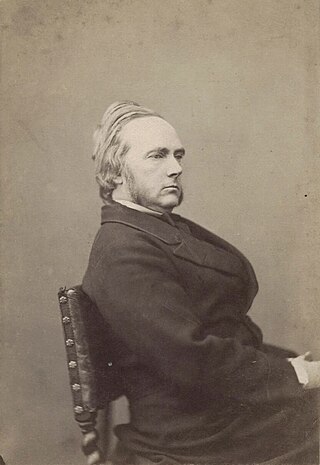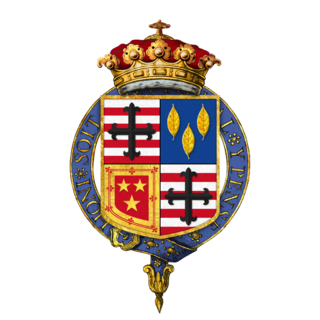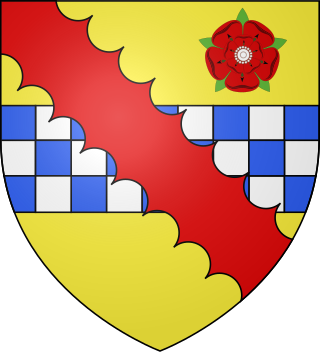
Duke of Sutherland is a title in the Peerage of the United Kingdom which was created by William IV in 1833 for George Leveson-Gower, 2nd Marquess of Stafford. A series of marriages to heiresses by members of the Leveson-Gower family made the dukes of Sutherland one of the richest landowning families in the United Kingdom. The title remained in the Leveson-Gower family until the death of the 5th Duke of Sutherland in 1963, when it passed to the 5th Earl of Ellesmere from the Egerton family.

Earl of Sutherland is a title in the Peerage of Scotland. It was created circa 1230 for William de Moravia and is the premier earldom in the Peerage of Scotland. The earl or countess of Sutherland is also the chief of Clan Sutherland.

George Howard, 6th Earl of Carlisle of Castle Howard,, styled Viscount Morpeth until 1825, was a British statesman. He served as Lord Privy Seal between 1827 and 1828 and in 1834 and was a member of Lord Grey's Whig government as Minister without Portfolio between 1830 and 1834.

Earl Granville is a title that has been created twice, once in the Peerage of Great Britain and once in the Peerage of the United Kingdom. It is now held by members of the Leveson-Gower family.

Earl of Cromartie is a title that has been created twice, both for members of the Mackenzie family. It was first created as Earl of Cromarty in the Peerage of Scotland in 1703 for Sir George Mackenzie, 2nd Baronet, but his titles were forfeited after the Jacobite rising of 1745. It was recreated in 1861 in the Peerage of the United Kingdom for Anne Sutherland-Leveson-Gower, Duchess of Sutherland. Since 1979, the Earl of Cromartie has been chief of Clan Mackenzie.

George John Douglas Campbell, 8th and 1st Duke of Argyll, was a British polymath and Liberal statesman. He made a significant geological discovery in the 1850s when his tenant found fossilized leaves embedded among basalt lava on the Island of Mull. He also helped to popularize ornithology and was one of the first to give a detailed account of the principles of bird flight in the hopes of advancing artificial aerial navigation. His literary output was extensive writing on topics varying from science and theology to economy and politics. In addition to this, he served prominently in the administrations of Lord Aberdeen, Lord Palmerston, John Russell and William Gladstone.
This is a list of people who have served as Lord Lieutenant of Shropshire. Before the English Civil War, the lieutenancy of Shropshire was always held by the Lord Lieutenant of Wales, but after the Restoration, its lieutenants were appointed separately. Since 1708, all the Lord Lieutenants have also been Custos Rotulorum of Shropshire.
This is a list of Lord Lieutenants of Cromartyshire, Scotland.

George Granville Leveson-Gower, 1st Duke of Sutherland KG, PC, known as Viscount Trentham from 1758 to 1786, as Earl Gower from 1786 to 1803 and as the Marquess of Stafford from 1803 to 1833, was an English politician, diplomat, landowner and patron of the arts from the Leveson-Gower family. He was the wealthiest man in Britain during the latter part of his life. He remains a controversial figure for his role in the Highland Clearances.

George Granville Sutherland-Leveson-Gower, 2nd Duke of Sutherland, KG, styled Viscount Trentham until 1803, Earl Gower between 1803 and 1833 and Marquess of Stafford in 1833, was a British peer and Whig politician from the Leveson-Gower family.

George Granville William Sutherland-Leveson-Gower, 3rd Duke of Sutherland,, styled Viscount Trentham until 1833, Earl Gower in 1833 and Marquess of Stafford between 1833 and 1861, was a British politician from the Leveson-Gower family.

Cromartie Sutherland-Leveson-Gower, 4th Duke of Sutherland,, styled Lord Cromartie Sutherland-Leveson-Gower until 1858, Earl Gower between 1858 and 1861 and Marquess of Stafford between 1861 and 1892, was a British peer and politician from the Leveson-Gower family.

George Granville Sutherland-Leveson-Gower, 5th Duke of Sutherland, KT, PC, styled Earl Gower until 1892 and Marquess of Stafford between 1892 and 1913, was a British courtier, patron of the film industry and Conservative party politician from the Leveson-Gower family. He held minor office in the Conservative administration of Bonar Law and Stanley Baldwin in the 1920s and was later Lord Steward of the Household from 1935 to 1936. As a noted patron of the British film industry, the Sutherland Trophy, awarded by the British Film Institute, is named in his honour.

Granville Leveson-Gower, 1st Earl Granville,, styled Lord Granville Leveson-Gower from 1786 to 1815 and The Viscount Granville from 1815 to 1833, was a British Whig statesman and diplomat from the Leveson-Gower family.
The Lord Lieutenant of Caithness is the British monarch's personal representative in an area defined since 1975 as consisting of the local government district of Caithness, in Scotland. This definition was renewed by the Lord-Lieutenants (Scotland) Order 1996. Previously, the area of the lieutenancy was the county of Caithness, which was abolished as a local government area by the Local Government (Scotland) Act 1973. The district was created under the 1973 act as a district of the two-tier Highland region and abolished as a local government area under the Local Government (Scotland) Act 1994, which turned the Highland region into a unitary council area.
The Lord Lieutenant of Ross and Cromarty, is the British monarch's personal representative in an area which has been defined since 1975 as consisting of the local government districts of Ross and Cromarty and Skye and Lochalsh in Scotland, and this definition was renewed by the Lord-Lieutenants (Scotland) Order 1996. Previously, the area of the lieutenancy was the county of Ross and Cromarty, which was abolished as a local government area by the Local Government (Scotland) Act 1973. The districts were created, under the 1973 act as districts of the two-tier Highland region and abolished as local government areas under the Local Government (Scotland) Act 1994, which turned the Highland region into a unitary council area.
This is a list of people who have served as Lord Lieutenant of Moray, Scotland. Until 1928 the office was known as Lord Lieutenant of the County of Elgin.
The Honourable Algernon Fulke Egerton, known as Algernon Leveson-Gower until 1833, was a British Conservative politician from the Egerton family.
Frederick Neville Sutherland Leveson-Gower was a British Liberal Unionist Party politician from the Leveson-Gower family.

Charles Stuart, 12th Lord Blantyre,, styled Master of Blantyre from birth until 1830, was a Scottish nobleman and landowner with 14,100 acres (57 km2) of titled lands.











